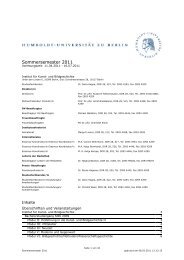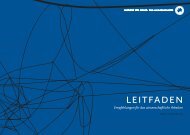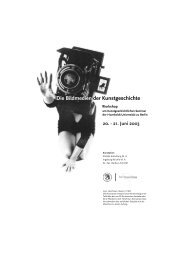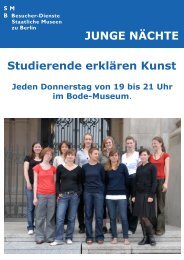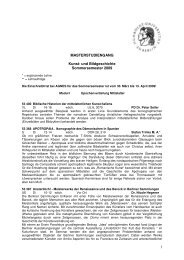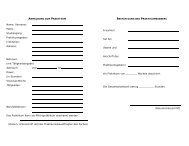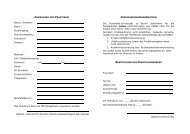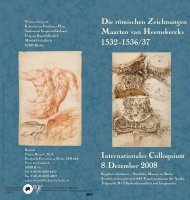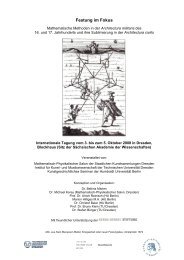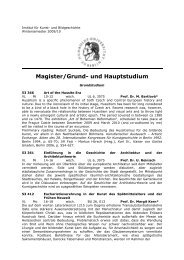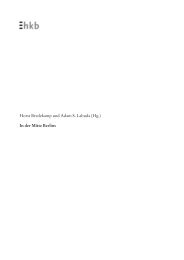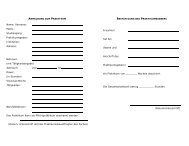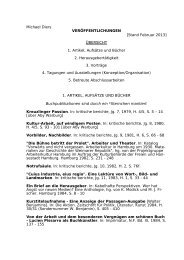Bauhaus Construct - Institut für Kunst
Bauhaus Construct - Institut für Kunst
Bauhaus Construct - Institut für Kunst
Create successful ePaper yourself
Turn your PDF publications into a flip-book with our unique Google optimized e-Paper software.
43 Reproduced in Wingler, <strong>Bauhaus</strong>, 98–101.<br />
The Irreproducibility of the <strong>Bauhaus</strong> Object<br />
44 For more on the role of trade shows in the display and sale of <strong>Bauhaus</strong> objects in the Weimar<br />
period, as well as efforts by the <strong>Bauhaus</strong> to bring early goods to market, see Rowland, “Busi-<br />
ness Management,” especially pp. 163–7.<br />
45 The basic plan of the <strong>Bauhaus</strong> to produce machine prototypes rather than the standard fare<br />
of a regular school of applied art was also reported in countless newspaper articles. For a<br />
typical example, see Dr Grote, “Das Weimarer <strong>Bauhaus</strong> und seine Aufgaben in Dessau,”<br />
Anhaltische Rundschau, 11 March 1925: 1.<br />
46 László Moholy-Nagy, “Eine bedeutsame Aussprache: Konferenz der Vertreter des <strong>Bauhaus</strong>es<br />
Dessau und des Edelmetallgewerbes am 9. März 1928 in Leipzig,” Deutsche Goldschmiede-Zeitung,<br />
no. 13 (1928): 123.<br />
47 Rudolf Arnheim, “Das <strong>Bauhaus</strong> in Dessau,” Die Weltbühne 23, no. 22 (31 May 1927): 921;<br />
translated in The Weimar Republic Sourcebook, ed. Anton Kaes, Martin Jay, and Edward<br />
Dimendberg (Berkeley: University of California Press, 1994), 451.<br />
48 <strong>Bauhaus</strong>, no. 4 (1927): 5. It was also reported that a related catalogue was in production.<br />
However, this relationship appears to have been short-lived, as the lamp division folded,<br />
causing the <strong>Bauhaus</strong> to begin anew in the search for a manufacturer. See Ise Gropius, Diary,<br />
30 November 1927, 205–6.<br />
49 A new contract for lighting came through in February of 1928, as noted in Ise Gropius’s diary<br />
(10 February 1928, 224). In the July 1928 issue, <strong>Bauhaus</strong> announced that both lighting companies<br />
Körting & Mathiesen and Schwintzer & Gräff were producing <strong>Bauhaus</strong> designs. See<br />
“Industrie und <strong>Bauhaus</strong>,” <strong>Bauhaus</strong>, no. 2–3 (1928): 33. For a full account of the <strong>Bauhaus</strong>’s<br />
relationship with Körting & Mathiesen and the line of modern lighting produced by the company<br />
from <strong>Bauhaus</strong> prototypes, see Justus Binroth et al., <strong>Bauhaus</strong>leuchten? Kandemlicht!<br />
Die Zusammenarbeit des <strong>Bauhaus</strong>es mit der Leipziger Firma Kandem/<strong>Bauhaus</strong> Lighting?<br />
Kandem Light! The Collaboration of the <strong>Bauhaus</strong> with the Leipzig Company Kandem (Leipzig:<br />
Grassi Museum, Museum <strong>für</strong> <strong>Kunst</strong>handwerk Leipzig; Stuttgart: Arnoldsche Art Publishers,<br />
2002). This arrangement, while fulfilling Gropius’s aims for the school, did so in an<br />
anonymous manner, because except for one mention in 1931, Körting & Mathiesen did not<br />
acknowledge the association of its Kandem line with the <strong>Bauhaus</strong> until its 75th anniversary,<br />
in 1964; see Ulrich Krüger, “Leutzsch Lighting: On the Collaboration of Körting & Mathiesen<br />
AG in Leipzig-Leutzsch with the <strong>Bauhaus</strong> in Dessau,” in Binroth, <strong>Bauhaus</strong>leuchten?, 11.<br />
50 Christian Wolsdorff, “<strong>Bauhaus</strong>-Produkte: Zusammenarbeit mit der Industrie,” in <strong>Bauhaus</strong><br />
Berlin: Auflösung Dessau 1932, Schließung Berlin 1933, Bauhäusler und Drittes Reich, ed.<br />
Peter Hahn (Weingarten: <strong>Kunst</strong>verlag Weingarten, 1985), 183. The pottery workshop also<br />
began to make contacts with—and supply models to—industry (porcelain and stoneware)<br />
but did not accompany the <strong>Bauhaus</strong> to Dessau, and ceased to exist.<br />
51 Gropius, “<strong>Bauhaus</strong> Produktion,” 130; translated in Wingler, <strong>Bauhaus</strong>, 110.<br />
52 Like Sachlichkeit, “Intellektuell-Sachliches” presents difficulties in translation; it could be<br />
translated as “intellectual factualness” or “intellectual objectiveness.”<br />
53 <strong>Bauhaus</strong>, no. 1 (1926): 3.<br />
54 Among the hundreds of photographs of Berlin interiors, both known and anonymous dwellings,<br />
at the Bildarchiv Preußischer Kulturbesitz in Berlin, there are relatively few modern<br />
interiors, and in these interiors, <strong>Bauhaus</strong> domestic objects are in scant evidence, while<br />
Breuer’s tubular steel chairs and <strong>Bauhaus</strong> furniture are fairly common. For example, the<br />
Breuer-designed apartment interior for Edwin Piscator, 1927, featured <strong>Bauhaus</strong> furniture and<br />
lighting fixtures but not its other products.<br />
55 Grete Lihotzky, “Rationalisierung im Haushalt,” Das neue Frankfurt, no. 5 (1926–1927): 120;<br />
translated in Kaes, Jay, and Dimendberg, Weimar Republic Sourcebook, 463.<br />
56 Fritz Wichert, “Ein Haus, das Sehnsucht weckt,” Frankfurter Zeitung, 10 October 1923.<br />
59



